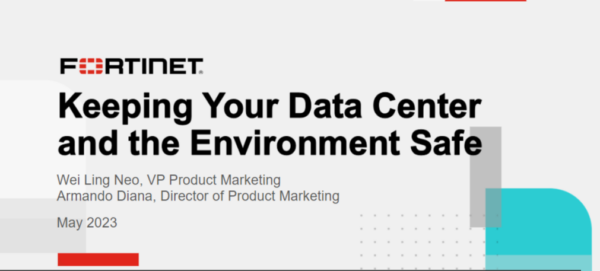M+E Connections

Fortinet: How to Keep Your Data Center and the Environment Safe
Story Highlights
Although data breaches and network threats tend to get most of the attention when protecting the data centre, chief information officers (CIOs) are also concerned with ensuring the data centre protects the environment, Fortinet pointed out during the May 18 webinar “Keeping Your Data Center and the Environment Safe.”
But juggling risk management while trying to navigate the data centre in the evolving network environment can be challenging for an organisation, according to Fortinet. Add on increasing environmental concerns and you have an even more complex task.
Fortinet pointed to a successful formula that organisations can go by: Improved performance + reduced complexity = a safer data centre.
“In today’s session, just to give you a brief overview, we’re going to talk about the market landscape,” Armando Diana, director of product marketing for the Data Center Firewall Solution at Fortinet, said at the start of the webinar. “We’re going to talk about some of the shifts in the market and some of the challenges faced by the data centre. Because of the shifts, we’ll talk about our vision for firewalls. And we’ll touch on some high level use cases.”
Moving on, he told viewers: “Most organisations were undergoing a transformation before the pandemic happened but, in fact, about 25 percent of the organisations worldwide were working from home.”
However, “then Covid hit and that accelerated the adoption of digital technologies to accommodate the new remote work environment and, today, about 62 percent of all organisations worldwide are working from home,” he said. “The ability for users to access the network and applications from anywhere and with any type of device has played a significant role in accelerating digital transformation,” he noted.
 That trend, he explained, has also been “facilitated by advancements in things like mobile devices, cloud computing, high speed internet.” Meanwhile, the “shift towards remote work has also led to the adoption of new technologies and approaches to collaborations like video conferencing and cloud-based file sharing,” he said.
That trend, he explained, has also been “facilitated by advancements in things like mobile devices, cloud computing, high speed internet.” Meanwhile, the “shift towards remote work has also led to the adoption of new technologies and approaches to collaborations like video conferencing and cloud-based file sharing,” he said.
Therefore, he noted: “The challenge for the data centre in this digital transformation world is how to [create] a consistent security posture.
Reflecting back, he said: “In the past, traffic just took one road to the data centre. It was a traditional north-south route but the traditional data centre morphed into a hybrid architecture to achieve scalability and agility. A lot of organisations, in order to be faster to market and satisfy their customers better, moved most of the data to the edge. So the traffic no longer took one road but multiple paths to the data centre. This traffic flow shift has led to several organisations struggling to manage external and internal risks to avoid downtime and also avoid losing millions of dollars per day.”
Citing third-party data, he said organisations have “deployed, on average, about 45 security tools across their network and it’s about 19 different solutions.” He explained: “So that means each incident requires the IT team to coordinate between 19 different solutions. So think about that for a second. Every time there’s a security incident, most organisations are manually touching up to 19 different solutions.”
There is a big problem with that, he said: “Such complexity inevitably leads to poor visibility, limited control and exploitable security gaps. That has led enterprises to want to consolidate their tools for better control and visibility.”
In addition, he said: “There’s intent-based segmentation. In the past, most remote workers accessed their corporate networks through VPNs. Once authenticated, they had carte blanche to access all the applications across the network. However, that is changing. Organisations are moving towards a zero trust network access approach where users must be authenticated for each application they want to access, even though they’re on the network and they’ve been authenticated to get onto the network. And, lastly, we have the sheer volume of data traversing the networks that is driving data centres to the hyperscale atmosphere.”
There are about 329 million terabytes of data created each day today, he went on to say. “That amounts to around 120 zettabytes of data generated each year. That sounds like I know what I’m talking about. I really don’t. But, to give you a sense of size, one zettabyte is equal to 1 trillion gigabytes of data. That’s an enormous amount of data, and that is difficult to comprehend in practical terms. But it gives you an idea of the massive scale [of] the digital world we’re living in today.” It also “expands the attack surface [area] exponentially,” he added.
Organisations today are often “creating complex workarounds to get solutions to mostly work together [and] this is leading the data centre infrastructure to become more complex as the amount of interconnected components try to provide a seamless flow of data between various system applications,” he also said. “In short, as the number of devices and the volume of data traffic increases, network complexity also increases, and that makes it more challenging to manage.”
Another challenge is increasing operational efficiency, he said. Meanwhile, “network managers are facing daily challenges and pressures to keep the business safe from cybercriminals,” he noted.
This is why the Fortinet security fabric is “powered by our single” operating system that “enables organisations to consolidate many technologies and use cases into a simplified single policy management framework,” he went on to tell viewers.
Wei Ling Neo, VP of product management for firewalls at Fortinet, went on to provide a demonstration to teach viewers about the sustainability for the data centre, risk management while juggling the need to be eco-friendly, and how Fortinet’s hybrid data centre cybersecurity delivers critical benefits.









